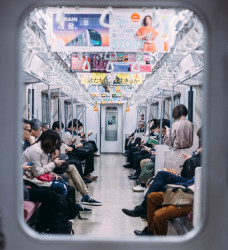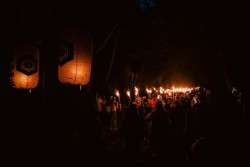
August 21, 2003
Easy Streets
Ocean breezes, smiling faces, exotic markets, and a laid-back pace. Catherine Pawasarat finds Japanese-style relaxation on the shores of the Noto Peninsula
By Metropolis
Originally published on metropolis.co.jp on August 2003

Photos by Catherine Pawasarat
The verdant Myojo-ji temple offers that otherworldly tranquility one somehow expects at Japanese temples, but rarely enjoys due to throngs of tourists. Most of the buildings date back to the 1600s, and the architecture-particularly a fine pagoda-is exceptional. With varied countenances, baroque décor, and traces of cobalt and crimson paint, the ancient (and gargantuan) guardian statues and minute celestial beings floating above lintels reveal an intriguing influence from mainland Asia.
This little-visited temple in the southwest corner of Noto Peninsula is just one of the area’s many charms. Reclining with its feet on Honshu and its head in the Japan Sea, Noto Hanto offers a great chance to tour windy, narrow coastal roads-by car or touring bike-with fantastic views of dramatic rock formations along the open water. It’s also a kind of ideal Japan, boasting serene temples, friendly locals and a lively morning market, as well as exquisite lacquerware and its own unique form of taiko drumming.
Keeping the faith
North of Myojo-ji the coast is pristine; the interplay of open sky and sea lined with craggy rock formations provide breathtaking scenery. Small hamlets are scattered here and there. A quick clamber along one coastal outcropping revealed Japan’s oldest-and, perhaps, shortest-wooden lighthouse with a doorway that looked like it was made for a hobbit.

Further north and inland is Sojo-ji temple, near the town of Monzen. Sojo-ji was the head temple of Zen Buddhism’s Soto sect from 1321 until the early 1900s, when this was still a formidably remote location. It remains a training temple, where guests can stay overnight and practice zazen, and when I saw young monks respectfully welcoming visitors at the main gate, I wondered-is this part of their modern ascetic practices?
Once inside the gate, a life-sized vermilion sculpture of a Chinese sage solemnly challenged me to show my Zen. The many small, individually-painted panels on the ceiling of the small Hoko-do were exquisite, and hinted at Buddhist themes: a crescent moon hovering above tossing ocean waves, a dragon clutching the pearl of wisdom, and a skull evoking human mortality.
I continued northward to the major city of Wajima. Here the daily morning market is fun and intriguing, with an almost Southeast Asian feel. Weather-worn wooden buildings line the streets and lean with age. Locals’ faces are similarly tanned and lined with decades of life at sea. The women proffer their regional wares and many dress in traditional garb, with pointed straw hats and indigo kasuri monpei trousers.

“You like chopsticks?” asked a vendor as I handed her the pair I wanted to buy. She didn’t wait for my answer, but popped the extra chopsticks in my bag for free. Others smiled while enthusiastically encouraging me to sample their produce, which ranged from the usual dried wakame seaweed to the more bizarre mounds of squid and octopus mouths piled on high.
Sights and sounds
The Noto peninsula is also famous for its lacquerware. There are a number of good museums in Wajima that show the region’s finest specimens, and places to observe ongoing production. There craftspeople sit seiza on tatami in small, virtually airless rooms, painstakingly painting and buffing down layer after layer of the sticky black goo until it’s as smooth and shiny as silk.
Nearby beckoned the Kiriko Kaikan, basically a warehouse full of the floats from the Wajima Taisai festival, and a sort of temple to regional Japanese kitsch. The floats are covered in lacquer and decorated with dramatic, three story-high paintings on washi such as a twisting dragon or mighty samurai. Tacky old gaijin mannequins in yukata pose comically on the floats, while the many smoking areas next to the blatantly flammable floats gave me something to scratch my head over. The Kaikan has good photos showing the astonishing feat of locals hoisting the massive structures on their shoulders around town and right out to sea.

Wajima also offers up a short nightly concert of Gojinjo Daiko, the local version of taiko drumming. Wearing ancient wooden masks of various demeanors, several local men threw themselves into the mesmerizing drumming with great zeal. As the story goes, 400 years ago townspeople discovered they were to be attacked by a great army. A handful of resourceful fishermen dressed up in oni (devil) masks, complete with seaweed hair, and beat furiously on drums all night. The would-be invaders were either frightened away or decided to disassociate themselves from such bizarre people, and a fine drumming tradition was born.
Moving along the coast to Sosogi, on the eastern side of the peninsula, I dropped in on Kamitokikunike, one of two historic homes still occupied by descendents of the Taira clan. Eight centuries ago some of the Taira escaped slaughter at the hands of the Minamoto by fleeing to remote Noto. The displayed artifacts are a little worse for wear, but provide an interesting window on life in exile. Family members still live here, and all radiate a dignified, melancholy air of what might have been-and what life can be outside Japan’s big cities.
Getting there
The Noto peninsula is easily accessible from Kanazawa City, which is 3.5hr and about ¥12,000 one way by train from Tokyo. Take the Max Asahi shinkansen to Echigoyuzawa (82min), then transfer to the Limited Express Hakutaka 6 (150min) to Kanazawa. Hokuriku Tetsudo runs 11 buses a day from Kanazawa to Wajima (stops in Sosogi), and four a day to Monzen. Both trips take about two hours and cost just over ¥2,200 one way (tel: 076-237-5115).
Where to stay
The tourist information offices inside Kanazawa station or next to the Wajima bus terminal supply maps and can assist with accommodation and travel bookings. The Noto peninsula is dotted with minshuku, with one night’s accommodation costing about ¥6,500/person with two meals. Lodging options in Wajima include Heiwa-so (tel: 0768-22-0318), Mangetsu (tel: 0768-22-4487) and Shiranami (tel: 0768-22-1180).
More information
The Wajima tourist information office can provide more maps and information than you’ll ever need. Being off the beaten path, it’s all in Japanese. If your language skills aren’t up to scratch, patience and a sense of adventure will serve you well. In Wajima, just about everything is within walking distance, or a quick ride by bike, car or taxi. More information is available at www.hot-ishikawa.jp/f-lang/english/index.html and www.jnto.go.jp/eng
[geo_mashup_map]







